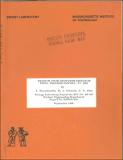| dc.contributor.author | Borzekowski, J. | en_US |
| dc.contributor.author | Driscoll Michael J. | en_US |
| dc.contributor.author | Best F. R. | en_US |
| dc.contributor.other | Massachusetts Institute of Technology. Energy Laboratory | en_US |
| dc.contributor.other | Massachusetts Institute of Technology. Department of Nuclear Engineering | en_US |
| dc.date.accessioned | 2014-09-15T18:13:02Z | |
| dc.date.available | 2014-09-15T18:13:02Z | |
| dc.date.issued | 1982 | en_US |
| dc.identifier.uri | http://hdl.handle.net/1721.1/89573 | |
| dc.description | Includes bibliographical references | en_US |
| dc.description | Final progress report; FY 1982 | en_US |
| dc.description.abstract | During the FY '82 campaign 14 new ion exchange resin formulations, prepared by the Rohm & Haas Company, were tested by MIT at the Woods Hole Oceanographic Institution. The best of these chelating resins was again of the acrylic amidoxime type; it picked up approximately 100 ppm uranium in seven days' exposure to seawater, which represents a factor of better than two improvement over thq seven-day results for the best FY '81 candidate (which saturated at roughly 100 ppm U after 30 days' exposure). Saturation was not reached and, within experimental accuracy, uranium accumulated at a constant rate over the seven-day period; it is speculated that a useful capacity of over 300 ppm U would be achieved. All resins of the styrenic amidoxime type were found to be an order of magnitude lower in their effective capacity for uranium in seawater than the best of the acrylic forms. Particle size effects, which were found to be less than expe!
cted from theoretical computations of both fluid and solid side mass transfer resistance, can not account for this difference. Scanning electron microscope examination by R & H scientists of ion exchange resin beads from beds subjected to seawater flow for 30 days in MIT's WHOI columns showed that the internal pores of the macro reticular- type resins become filled with debris (of undetermined nature and effect) during exposure. | en_US |
| dc.format.extent | vi, 43 pages | en_US |
| dc.publisher | Cambridge, Mass. : Massachusetts Institute of Technology, Energy Laboratory, 1982 | en_US |
| dc.relation.ispartofseries | Energy Laboratory report (Massachusetts Institute of Technology. Energy Laboratory) ; no. MIT-EL 82-037 | en_US |
| dc.relation.ispartofseries | MITNE ; no. 254 | en_US |
| dc.subject.lcc | TK1001.M41 E56 no.82-037 | en_US |
| dc.subject.lcc | TK9008.M41 N96 no.254 | en_US |
| dc.subject.lcsh | Uranium | en_US |
| dc.subject.lcsh | Marine mineral resources | en_US |
| dc.subject.lcsh | Seawater -- Analysis | en_US |
| dc.title | Uranium from seawater research : final progress report, FY 1982 | en_US |
| dc.title.alternative | Seawater research, Uranium from | en_US |
| dc.type | Technical Report | en_US |
| dc.identifier.oclc | 10662004 | en_US |
